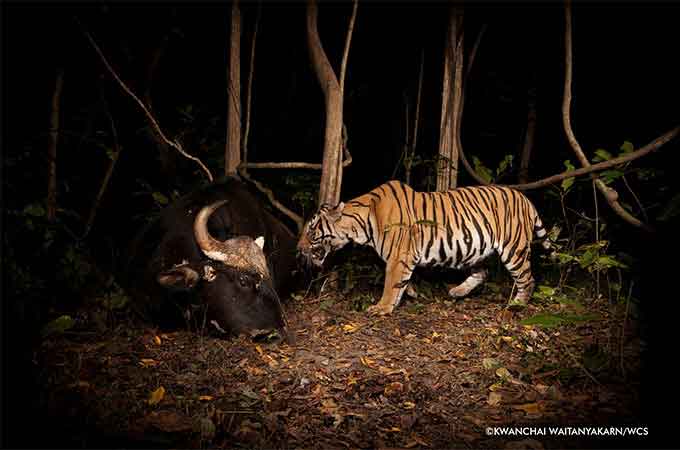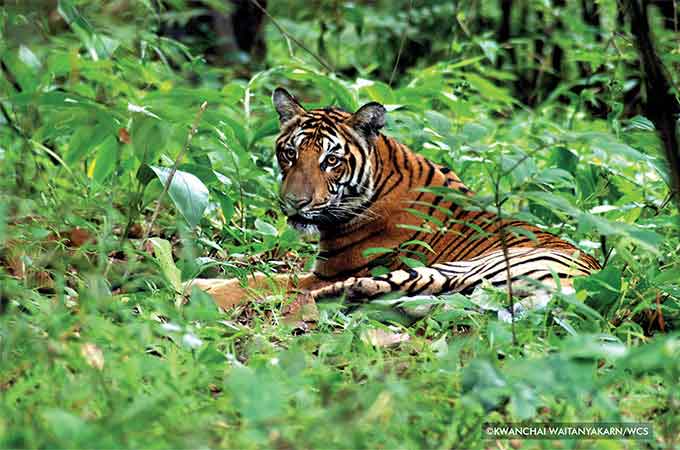Status, Habitat, and its roles in the Ecosystem
Tigers (Panthera tigris) are one of the largest predators in the world. Each tiger has their own large territory in which males have a larger home range size than females. According to tiger research (Panthera tigris corbetti) in Huai Kha Khaeng Wildlife Sanctuary, which has been studied by Khao Nang Rum Wildlife Research Station, found that male tigers have a home range size of approximately 267-300 km2 while females home range size is about 60-70 km2. Tigers usually hunt alone at night or at dawn, they are a solitary species except when females feed their cubs.
Female tigers reach maturity at 3 years old while males will reach maturity at 4 or 5 years old. Tigers are non-seasonal breeders. During mating, males and females stay together for 4-5 days and can copulate every 15-20 minutes. Female gestation period is about 100-103 days and can give birth to 2-4 cubs per litter. There is a 50 to 70% chance that tiger cubs can survive and reach adulthood. However, tiger cubs cannot survive without their mother until they reach 18-24 months old, after that they will separate from their mother and start finding their own territories.
Tiger's subspecies
Historically, hundreds of thousands of tigers (Panthera tigris) roamed across Asia. The largest tiger population is now in India, but there are wild populations in numerous Asian countries. Their historical range in Siberia, west Asia, Indian peninsula, Korean peninsula, South China, Southeast Asia, Java, Sumatra, and Bali is severely diminished. Today, tigers occupy only 7 percent of their historical range. There are eight subspecies of tiger, three of which are extinct.
The extincted subspecies are:
1. Bali tiger (Panthera tigris balica)
The smallest of all tiger subspecies, with an average weight of 80-100 kg, darkest skin and smallest stripes. These tigers were once inhabited in Bali Island, Indonesia. The latest record was found in 1940 and they went extinct in 1950.
2. Javan tiger (Panthera tigris sondaica)
With similar features but slightly bigger than the Bali Tiger, the Javan tiger has dark skin and small stripes with an average weight of 110-140 kg. This small-sized tiger previously lived in Java Island, Indonesia. The latest record was found in 1972 and they went extinct in 1976.
3. Caspian tiger (Panthera tigris virgata)
Caspian tigers are similar to Siberian tigers but they have darker skin and tend to be a medium-sized tiger. Its average weight is around 140-240 kg. Its historical habitats are in Turkmenistan, Uzbekistan, Afghanistan, Iran, Turkey, and Mongolia. The latest record was found in 1948 and they went extinct in 1952.
The surviving subspecies are:
1. Indo-Chinese tiger (Panthera tigris corbetti)
These are slightly smaller and darker than the Bengal tiger, with shorter, narrower stripes. It is the medium-sized weighing approximately 130-200 kg. Its ranges are in small protected areas in Thailand, Myanmar, Laos, Cambodia, Vietnam, and Southern China.
2. Royal Bengal tiger (Panthera tigris tigris)
Bengal tigers are second only to the Siberian tiger in size. In fact, some Bengal tigers from the Indian state of Assam are as large as Siberian tigers. There is wide variation in their striping patterns. A specific feature of Bengal tigers is their black ear. The large tiger weights around 160-260 kg. Its ranges are in small protected areas in India, Nepal, Bhutan, Bangladesh, and western forest of Myanmar.
3. Siberian tiger (Panthera tigris altaica) (also known as the Amur tiger)
The largest tiger subspecies and also making them the biggest cats in the world with a weight of approximately 170-300 kg. They have pale coats with brownish stripes. Their fur grows very long and shaggy in winter to survive in the snowy landscape of Far East Russia. They may also be found in Northeast China and North Korea.
4. South China tiger (Panthera tigris amoyensis)
The medium sized tiger weighs around 120-150 kg. Their distinguishing features are shorter, broader, and less numerous stripes than other subspecies. The species is now the most endangered in the world with no more reports of tigers found in the wild. Most of them are adopted in Chinese zoos. Its ranges are in central and eastern China.
5. Sumatran tiger (Panthera tigris sumatrae)
The smallest tiger subspecies with a weight of around 90-120 kg. They have dark, reddish-brown coats with broad black stripes. And are only found in Sumatra, Indonesia.

Feeding Ecology of Tigers
From basic principles of animals energetic that tiger's prey must be over 20 kg. Density of prey species influence tiger densities in several ways. As prey density declines, breeding female ranges become larger, dramatically reducing the number of such females that an area can support. High prey densities appear to permit the area to support higher number of transient animals (Karanth and Nichols 1998, 2000). Because cub and juvenile survival rates are higher when prey availability is higher, the numbers of tiger in these two demographic stages are also higher. While other habitat-related or managerial factors also influence tiger density at a given site, prey abundance appears to be the primary ecological determinant in most places (Karanth and Nichols 2002).
Principal prey species indicates dynamic tiger abundance. In India, a study about feeding ecology of tigers reveals that, in one year, a tiger requires prey weighing an average of 3,000 kg which is approximately 50 adult spotted deer. This implies that to expect the reproduction of 50 chital, we have to reserve the existing amount of at least 500 spotted deer.
Effective tiger survey methods; population count on sighting, detecting signs, etc., influence the effective result of tiger abundance. At the same time, the high abundance of tiger population can be an effective, reliable site study on the relation between tigers and their prey species as well.

Relationship between tigers and prey
A research on tiger’s prey species in Huai Kha Khaeng Wildlife Sanctuary reveals that the main preys are ungulates such as; bantengs, sambar, muntjac, gaur and wild pig. And most of them are adults (Simcharoen, 2000). Whereas, some of them are also the prey species of leopard, the leopard prefer juvenile or subadult (Simcharoen, 2003).
From the hunting behavior study found that tigers mostly grab and bite their prey on neck until it die. To bite on neck keeps them safe from the prey’s antlers and hooves (Karanth, 1995). After the prey died, the tiger will drag to eat at a safe place. Normally, tiger hunts large prey. The experienced adult tiger hunts carefully and in the case may cause the least injury (Schaller, 1976).
A tiger requires about 54 ungulates each year. Tiger feeds around 18 - 40 kg in each time, starts from hip of the prey. Without interruption, it will take 3 - 6 days to finish (Sunquist, 1981). In India, it is reported that a single female hunts every 8 - 8.5 days. As Schaller (1967) had studied and monitored tigers’ behavior in the wild, he found that from the 12 times of their attempt, only one is successful.